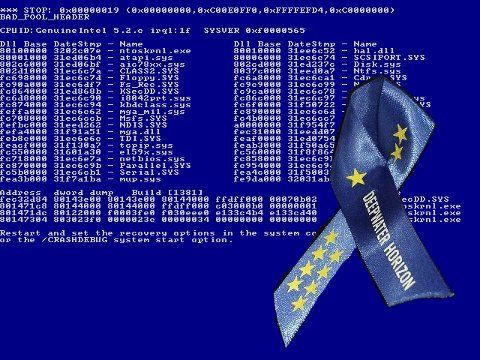10.12.10
Posted in GNU/Linux, Google, Microsoft, Patents, SCO, UNIX at 4:11 am by Dr. Roy Schestowitz

Summary: As a resort to losers there is always litigation and this is where Microsoft is going, still hoping to prove that no Free/libre software is free (gratis), this time because of software patents as opposed to copyrights (UNIX)
MICROSOFT’S DIRECTION increasingly resembles that of SCO. Yes, the “free is expensive” line was previously used against Linux, even prior to SCO’s lawsuit against IBM and others. “Just to point out [...] Android runs on Linux,” wrote Groklaw some days ago, “so this is more of the same old, same old Microsoft. [...] When companies can’t compete any more, like SCO, they think of suing for license fees, I guess. But why would that make you want to buy anything from them? No one respects a bully, as SCO found out.” Groklaw still watches the SCO case against Novell. Techrights has watched the Microsoft patent fight against Linux since its dawn in November 2006.
Further promoting the idea that no mobile operating system can be free of charge, Microsoft recently paid Acacia [1, 2], the patent troll which bothers Red Hat. This leads to the perception that there is debt to be paid, whether this was Microsoft’s intent or not.
Android ain’t free, according to this article from CNN whose headline says that “Microsoft gets paid”. We have warned about this years in advance and called for opposition against it.
On the back of the news that Microsoft (MSFT) is suing Motorola (MOT) for patent infringments related to Android, Steve Ballmer tells the Wall Street Journal that HTC is paying a license fee for its use of Android…and that other Android manufactures may be forced to do the same.
WSJ: Is that difficult in an environment where Android is free?
Mr. Ballmer: Android has a patent fee. It’s not like Android’s free. You do have to license patents. HTC’s signed a license with us and you’re going to see license fees clearly for Android as well as for Windows.
WSJ: It doesn’t seem like the license fee alone is a big financial opportunity for Microsoft.
Mr. Ballmer: It’s one of the opportunities. One.
“Microsoft becoming the next SCO” says this headline from The Source, which takes the opportunity to warn Mono and Moonlight proponents.
And some desillusioned people still believe Mono/Moonlight would be free (and safe from Microsoft) if it ever would have the same sucess as Android…!
ITWire has similar remarks to make in the new article “Microsoft’s new spin: Android isn’t free”:
Microsoft chief executive Steve Ballmer told The Wall Street Journal in an interview: “Android has a patent fee. It’s not like Android’s free. You do have to license patents. HTC’s signed a license with us and you’re going to see license fees clearly for Android as well as for Windows.”
A trustworthy and typically speculations-free Web site opines that Microsoft’s Android lawsuit may be payback for Motorola’s Windows Mobile defection.
Google responded to Microsoft’s patent infringement lawsuit against Motorola over Android smartphones, saying the legal action “threatens innovation.” Meanwhile, analysts speculate on the timing and target of the lawsuit, with one analyst calling it payback against Motorola for abandoning Windows Mobile, and another suggesting the lawsuit is covering fire for Microsoft’s upcoming Windows Phone 7 release.
Motorola ought to protest against Microsoft’s aggression rather than do something similar under the “he started it” defence. For more information about Motorola, see our Wiki about the company. █
Permalink
 Send this to a friend
Send this to a friend
Posted in Apple, Deception, Marketing at 3:37 am by Dr. Roy Schestowitz

Summary: Apple is trying quite hard to protect its reputation and this involves hiding the truth about known issues that affect existing customers
• Apple reportedly taking steps to head off iPhone ‘glassgate’ [via]
Apple is reportedly working behind the scenes to address scratching and cracking of the iPhone’s glass back panel by certain third-party cases.
• With Antennagate over, is Glassgate next for the iPhone 4?
But there’s another issue brewing behind the scenes that’s sent Apple’s iPhone engineering team back into the bunker for preemptive damage control. If you’ve been into an Apple Store (or visited Apple’s site) recently, you might have caught a hint while browsing iPhone 4 cases (or lack thereof). Although Apple has just this week reestablished a wide variety of cases for sale, as of only a couple of days ago the only iPhone 4 case Apple even so much as mentioned on its site was its own first-party Bumper — and still conspicuously absent from its lineup are slide-on cases. As it turns out, was by no means a cynical ploy to maximize profits.
• Blogger stokes iPhone 4 shatter fears
We’re not sure how seriously to take claims that some third-party iPhone 4 cases can cause the handset’s rear glass panel to shatter.
To be fair, no one appears to have suggested that this has actually happened. But it is alleged by Gdgt.com that Apple engineers are busy investigating this potential problem, implying that the company is sufficiently worried that broken phones – and, by extension, a broken reputation – are a possibility.
Permalink
 Send this to a friend
Send this to a friend
Posted in Microsoft, Windows at 2:48 am by Dr. Roy Schestowitz

Summary: An analysis of the causes that led to the Deepwater Horizon blowup (or what failed to prevent it), based on the long inquiry
THE previous post spoke about Stuxnet, which endangers many people whose company/authority/personal computer runs Microsoft Windows. Another recent disaster where Windows got some blame was the Deepwater Horizon blowup [1, 2, 3, 4]. An anonymous Techrights contributor wrote an update on the topic — one which we publish below.
“Here’s an update on the Deepwater Horizon story, “he writes, “New testimony spurred me to look up transcripts that had not been published at the time. There were several bombshells worth sharing and thinking about. For example, Windows NT is named and shamed by the expert witness. Windows was not mentioned in most press coverage but it seems to have played a more central roll than even I expected.”
Here is the report in question PDF and corresponding interpretation:
Windows NT and the Deepwater Horizon
A buggy control system left drillers and the rig blind and might even have damaged a critical safety system on the sea floor.
Microsoft Windows may have been directly responsible for Deepwater Horizon catastrophe. Previously, Techrights showed that Microsoft Windows played a crucial role. A 824 page transcript from the July 23 Deepwater Horizon investigation has been posted and we can see that things were as Techrights guessed. Mr. Williams describes Windows NT, “a very unstable platform” as the root cause of most problems. This buggy Windows based control system left drillers blind when it crashed daily was responsible for safety system bypasses and may have destroyed the annular seal. New testimony from Andrea Fleytas, who operated the alarm panels on the doomed bridge and jumped from the flaming deck with Mr. Williams, shows that the drilling team may have had time to escape if the alarms were not inhibited. This interpretation of her testimony, with some quotes, was published by the Times Picayune. The consequences of this disaster and ongoing cover up are well reported in the Florida Oil Spill Law blog.
Mr. Williams describes typical Windows problems in three identical, malfunctioning control systems, A Chair, B Chair and C Chair, on pages 42 and 101. There’s incompatibility, instability, harmful bugs and worries about viruses. On page 42, Mr. Williams talks about the systems, their importance and how broken they were.
The A-chair is located in the dog house. That is the main operating point for the driller to control all drilling functions. It controls everything from mud pumps to top drive, hydraulics. It controls everything.
For three to four months we’ve had problems with this computer simply locking up. [sometimes it was a blue screen, sometimes a frozen display] … We had ordered replacement hard drives from the manufacturer. We had actually ordered an entire new system, new computers, new servers, new everything to upgrade it from the very obsolete operating system that it was using. Those computers were actually using Windows NT, which is a very unstable platform to begin with.
Between the manufacturer and the rig, they could not get the bugs worked out of the new operating system. They couldn’t get the old software to run correctly on the new operating system. Our sister rig, the NAUTILUS, was going through those growing pains kind of for us. We had already ordered all the equipment. We were just waiting on them to figure it all out so that we could copy their learnings and make it work on our rig.
Meanwhile, we were limping along with what we had. We had ordered new hard drives. They came in. We replaced the images on the hard drives for the software imaging, got them back running, the chair would run for two, three days, and they would crash again. … I can’t tell you how many hours or days he [electrical supervisor, Tommy Daniels] spent focused entirely on getting these chairs resolved. … He was still working towards that up until the time of the explosion. It had not been resolved.
In the same discussion, Mr. Williams attributes the blowout to the failure of this system by referencing a previous incident.
[in another accident] It was internally discussed that the chair crashing caused the kick, because they lost all — They lost all communications to the drill package. They had no way to monitor anything for several seconds, and before they could get the B Chair up, they had taken a kick.
On pages 103 and 104, he also describes how a “blue screen of death” could lead to a “kick” while waiting for the backup system to boot and be informed by “servers”. Operators complained about this loss of control every day and it happened at all hours of the day and night.
It should be noted that the problem with the alarms was not the sensors but it could have been viruses. Mr. Williams describes how he made sure all of those were working properly on pages 66 and 68 to 70. On page 77, Williams says, “The chairs themselves were completely independent and isolated from the entire rig network, so there was no chance of infection, virus, hacking, there was no opportunity for that.” This tells us that the rest of the network had problems that might have been carried to the control system via physical media, like USB drives or floppies.
Non free software left BP engineers in the field divided and helpless. On page 102, Mr. Williams tells us, “There was no fixing bad software. We could simply manage it, try to keep it running.” So, BP’s management was told that all they could do was as the vendor says. Money and resources were being spent to fix the problems but they were wasted. When the vendor’s software failed, BP was stuck begging for more from a system that had to be bypassed.
Mr. Williams describes the general alarm, its inhibition and consequences starting on page 30. The whole rig was blind to real danger.
.
You have four states of alarms. You have a normal operating condition, you have an inhibited condition, which simply means that the sensory is active, it is sensing, and it will alarm and it will give the information to the computer but the computer will not trigger an alarm for it. It will give you the indication, but it won’t trigger the actual alarm. [other states described] …
there are several toxic and combustible gas sensors located in key areas, mainly around the drilling package. … When you get two detectors to go into a high state in one zone, what is supposed to happen is the ESD for that zone should trip, which is your emergency shutdowns [designed to prevent explosions], and you should also sound the generator alarm.
The general alarm is set up to inform the entire rig of any of three conditions. … Each one of those conditions has a distinct tone and a distinct visual light. We have light columns throughout the rig. One red — Within the column there’s a red, a yellow, and a blue, with the red being fire, yellow being toxic, blue being combustible. So you get an audio tone and a visual tone with every general alarm. [none of these were used in the accident because the computer was set so general alarms had to be triggered manually. As we will see, they failed to do this.]
… When I discovered it was inhibited about a year ago, I inquired as to why it was inhibited, and the explanation I got was that they — from the OIM down, they did not want people woke up at 3:00 o’clock in the morning due to false alarms.
On pages 40 and 41 we see that Emergency Shut Downs had been set to bypass because the system shut panels down frequently over false alarms. This left everyone at risk of explosion.
On page 37, Mr. Williams drops another bombshell, that the same system may have destroyed the blow out preventer without human input. A reasonable system would inhibit motion, even human directed motion, that would destroy itself. What they had left them wondering about everything.
it took me a few days to understand or to formulate why we were getting chunks of [annular] rubber back. There was an incident prior to that where we were in testing mode and the annular was closed around the drill pipe. I got a call from the night-time toolpusher to come investigate whether or not there was an input to the stick to hoist the block while the annular was closed, and I inquired as to why he needed to know that. He said, “Well, the block moved about 15 or 20 feet. We need to know why. We need to know if it was inadvertent stick movement or if it went up by itself.” [an informal investigation] got into the chair log data and dissected the data. What we determined was one of the sticks was moved in the positive direction. What we could not definitively determine was which stick. The tag system inside the log was not accurate enough. It simply said, “Joystick A, Joystick B,” …
All the logs prove to me is that the computer thought someone pushed the joystick. The signal was erroneous and might also have been spurious.
The most dreadful immediate consequence of all of this was that eleven men died in an explosion and fire. New testimony shows a situation that a more reasonable system should have been able to react to and save the day. The blow out preventer should never have been damaged. Alarms should have sounded, so people could escape. Panels and generator should have been shut down to prevent an explosion. What actually happened? David Hammer of the Times Picayune tells us.
Andrea Fleytas said she felt the rig jolt that evening and saw more than 10 magenta lights flash on her screen notifying her that the highest level of combustible gas had entered the rig’s shaker house and drill shack, critical areas where the rig’s drilling team was at work. … she was trained to sound a general alarm any time more than one indicator light flashed, but didn’t do so immediately in this case because she had never been trained to deal with such an overwhelming number of warnings. … she eventually “went over and hit the alarms” after the first or two large explosions.
[before pushing the alarms] Fleytas received a telephone call from crew members on the drill floor who said they were fighting a kick of gas and oil in the well; she took another call from the engine control room asking what was happening and she told them they were having a well control problem; and she continued to hit buttons on her console acknowledging the multiple gas alarms popping up in various sectors of the rig. … A few seconds after she got off the telephone with the engine room, there was a blackout on the rig. A few seconds after that, the first explosion rang out, Fleytas testified. It was then that she sounded the general alarm.
Keplinger said in his own testimony that it was after the explosion when he first “noticed a lot of gas in there and called” the shaker house to try to get whoever may have been there out, but nobody answered the phone.
Fleytas said she knew of no protocols for activating the emergency shutdown and no one activated it. Gas likely ignited in the drilling area, killing everyone there, and also caused the two active engines to rev so high that all power on the rig was lost, preventing fire pumps from working and keeping the rig from moving away from the spewing well.
Microsoft failure did not end when the rig sank. Those trying to fix things were also burdened with second rate software.
Since then, people from Texas to Florida have been sickened and harmed by the spill. Toxic levels of dispersant have shown up in people’s private pools, the beaches are contaminated with about 200 ppm of oil, oysters, crabs and shrimp have even more. The oil made its way into people’s blood. If the big spill in Mexico is a guide, the spill will linger for decades [2]. █
Permalink
 Send this to a friend
Send this to a friend
Posted in Microsoft, Security, Windows at 2:18 am by Dr. Roy Schestowitz

Summary: The Windows worm which has already raised nuclear tension is claimed to be doing damage all across the planet and outside the planet too
“Did The Stuxnet Worm Kill India’s INSAT-4B Satellite,” asked Sag Arun in relation to this short Stuxnet report from Forbes. It seems reasonable to assume a correlation.
On July 7, 2010, a power glitch in the solar panels of India’s INSAT-4B satellite resulted in 12 of its 24 transponders shutting down. As a result, an estimated 70% of India’s Direct-To-Home (DTH) companies’ customers were without service. India’s DTH operators include Sun TV and state-run Doordarshan and data services of Tata VSNL.
[...]
I uncovered this information as part of my background research for a paper that I’m presenting at the Black Hat Abu Dhabi conference in November. My objective for that presentation will be to provide an analytic model for determining attribution in cases like Stuxnet. My objective for this post is simply to show that there are more and better theories to explain Stuxnet’s motivation than just Israel and Iran, as others have posited. My personal research won’t be available until after Black Hat Abu Dhabi, however I hope others will pick up this thread, give it a good yank, and see what unravels before then.
Iran is now denying that Stuxnet was the cause of nuclear problems:
Delays in bringing Iran’s nuclear plant online at Bushehr are due to a “small leak” and nothing to do with the infamous Stuxnet worm, according to the country’s energy minister.
“Stuxnet Worms On” says Slashdot, which has a new summary with links:
Numerous Stuxnet related stories continue to flow through my bin today, so brace yourself: Unsurprisingly, Iran blames Stuxnet on a plot set up by the West, designed to infect its nuclear facilities. A Symantec researcher analyzed the code and put forth attack scenarios. A Threatpost researcher writes about the sophistication of the worm. Finally, Dutch multinationals have revealed that the worm is also attacking them. We may never know what this thing was really all about.
“Stuxnet ‘a game changer for malware defence’,” says The Register
The worm, whose primary method of entry into systems is infected USBs, essentially ignores vulnerable Windows boxes but aggressively attacks industrial control (SCADA) systems from Siemens, establishing a rootkit as well as a backdoor connection to two (now disconnected) command and control servers in Malaysia and Denmark.
Suffice to say, it is a Windows-only problem. Some of the mainstream press still neglects to point it out. More posts about Stuxnet can be found below. █
- Ralph Langner Says Windows Malware Possibly Designed to Derail Iran’s Nuclear Programme
- Windows Viruses Can be Politically Motivated Sometimes
- Who Needs Windows Back Doors When It’s So Insecure?
- Windows Insecurity Becomes a Political Issue
- Windows, Stuxnet, and Public Stoning
- Stuxnet Grows Beyond Siemens-Windows Infections
- Has BP Already Abandoned Windows?
- Reports: Apple to Charge for (Security) Updates
- Windows Viruses Can be Politically Motivated Sometimes
- New Flaw in Windows Facilitates More DDOS Attacks
- Siemens is Bad for Industry, Partly Due to Microsoft
- Microsoft Security Issues in The British Press, Vista and Vista 7 No Panacea
- Microsoft’s Negligence in Patching (Worst Amongst All Companies) to Blame for Stuxnet
- Microsoft Software: a Darwin Test for Incompetence
- Bad September for Microsoft Security, Symantec Buyout Rumours
- Microsoft Claims Credit for Failing in Security
- Many Windows Servers Being Abandoned; Minnesota Goes the Opposite Direction by Giving Microsoft Its Data
- Windows Users Still Under Attack From Stuxnet, Halo, and Zeus
- EU Concerns Highlight Need to Remove Windows From the Network
Permalink
 Send this to a friend
Send this to a friend





















 Content is available under CC-BY-SA
Content is available under CC-BY-SA